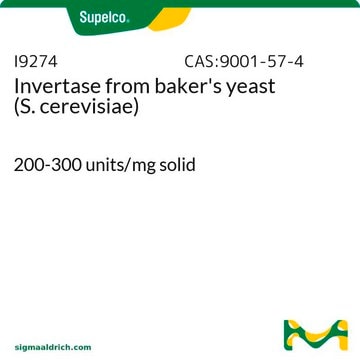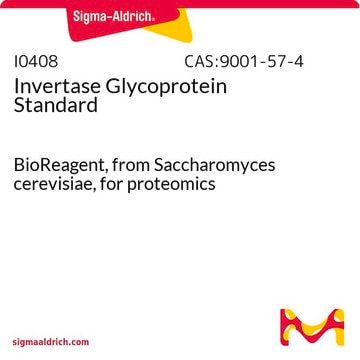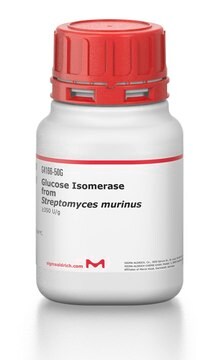I4504
Invertase from baker′s yeast (S. cerevisiae)
Grade VII, ≥300 units/mg solid
Synonym(s):
β-D-Fructofuranosidase, β-D-Fructofuranoside fructohydrolase, Saccharase
Sign Into View Organizational & Contract Pricing
All Photos(3)
About This Item
Recommended Products
biological source
bakers yeast
type
Grade VII
form
solid
specific activity
≥300 units/mg solid
foreign activity
α-galactosidase (melibiase) ≤0.01%
storage temp.
−20°C
Looking for similar products? Visit Product Comparison Guide
Application
Used in the production of confectionary foods and artificial honey.
Biochem/physiol Actions
Invertase hydrolyzes sucrose into glucose and fructose yielding a colorless product, unlike acid hydrolysis which produces colored products.
Unit Definition
One unit will hydrolyze 1.0 μmole of sucrose to invert sugar per min at pH 4.5 at 55°C.
Signal Word
Danger
Hazard Statements
Precautionary Statements
Hazard Classifications
Resp. Sens. 1
Storage Class Code
10 - Combustible liquids
WGK
WGK 3
Personal Protective Equipment
dust mask type N95 (US), Eyeshields, Gloves
Certificates of Analysis (COA)
Search for Certificates of Analysis (COA) by entering the products Lot/Batch Number. Lot and Batch Numbers can be found on a product’s label following the words ‘Lot’ or ‘Batch’.
Already Own This Product?
Find documentation for the products that you have recently purchased in the Document Library.
Customers Also Viewed
Tatiana Q Aguiar et al.
Molecular biotechnology, 56(6), 524-534 (2014-01-24)
The repertoire of hydrolytic enzymes natively secreted by the filamentous fungus Ashbya (Eremothecium) gossypii has been poorly explored. Here, an invertase secreted by this flavinogenic fungus was for the first time molecularly and functionally characterized. Invertase activity was detected in
Organic Waste-Based Fertilizer in Hydroponics Increases Tomato Fruit Size but Reduces Fruit Quality.
Dmitry Kechasov et al.
Frontiers in plant science, 12, 680030-680030 (2021-07-13)
In regions with intensive agricultural production, large amounts of organic waste are produced by livestock animals. Liquid digestate from manure-based biogas production could potentially serve as fertilizer if integrated with closed horticultural irrigation systems. The aim of this experiment was
Misa Sandri et al.
Animal nutrition (Zhongguo xu mu shou yi xue hui), 6(3), 353-361 (2020-10-03)
A dietary intervention study was assessed to determine if different sources of starch in homemade diets could significantly modify fecal microbiome of dogs. Twenty-seven adult dogs were enrolled and fed a diet based on a mixture of rice and pasta
Ali Soltani et al.
BMC genomics, 20(1), 312-312 (2019-04-25)
Climate change models predict more frequent incidents of heat stress worldwide. This trend will contribute to food insecurity, particularly for some of the most vulnerable regions, by limiting the productivity of crops. Despite its great importance, there is a limited
Bryan J Leong et al.
Science advances, 5(4), eaaw3754-eaaw3754 (2019-04-30)
Plants produce a myriad of taxonomically restricted specialized metabolites. This diversity-and our ability to correlate genotype with phenotype-makes the evolution of these ecologically and medicinally important compounds interesting and experimentally tractable. Trichomes of tomato and other nightshade family plants produce
Protocols
Enzymatic Assay of Invertase
Our team of scientists has experience in all areas of research including Life Science, Material Science, Chemical Synthesis, Chromatography, Analytical and many others.
Contact Technical Service











